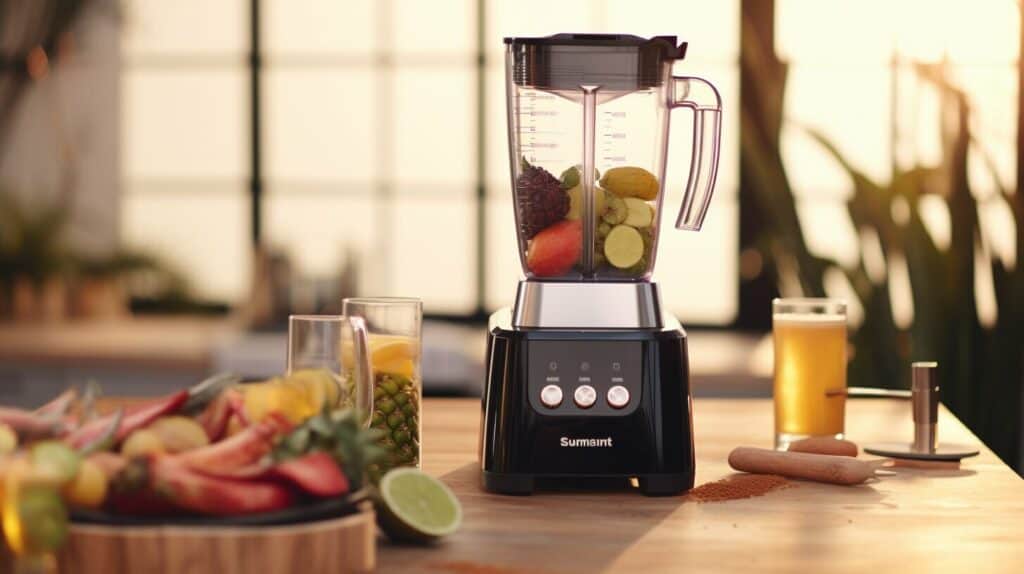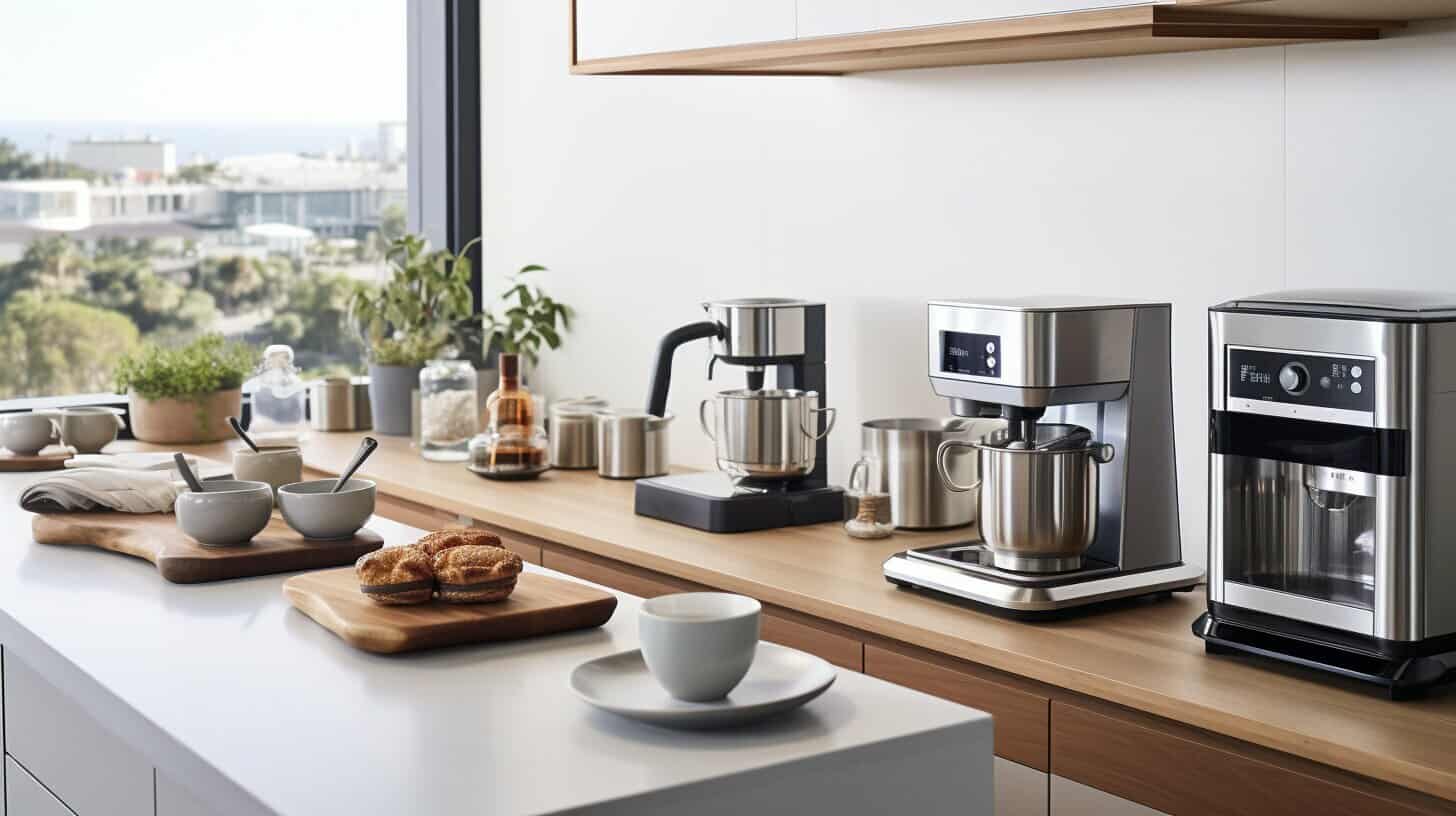So, you’re considering taking the plunge and investing in a Cuisinart product, eh? Whether it’s for whipping up your grandma’s secret spaghetti sauce or impressing your friends with a home-cooked feast, this brand might be on your radar. But is Cuisinart a good choice? Stick around, and let’s dive into the nitty-gritty of what makes this brand sizzle—or fizzle.
Cuisinart is a reputable brand known for its innovative kitchen appliances. Their products offer a blend of quality, performance, and stylish design, making it a favored choice among home cooks and professionals alike.
This Brand Is Suitable For:
| Action: | Description: |
|---|---|
| Chopping Vegetables: | With Cuisinart’s food processors, chopping veggies is a breeze. |
| Baking Bread: | Cuisinart’s bread machines make homemade breadmaking easy. |
| Grilling Steaks: | Grill like a pro with Cuisinart’s outdoor grills. |
| Making Smoothies: | Cuisinart blenders create silky smoothies in seconds. |
| Frying Eggs: | Cuisinart’s non-stick pans are perfect for flipping eggs. |
| Brewing Coffee: | Start your day with a fresh cup from a Cuisinart coffee maker. |
| Whipping Cream: | Cuisinart mixers make whipping cream a piece of cake. |
| Cooking Rice: | Cuisinart rice cookers ensure fluffy rice every time. |
| Toasting Bread: | Toast to perfection with a Cuisinart toaster. |
| Steaming Vegetables: | Enjoy healthy meals with Cuisinart’s efficient steamers. |

Opinion Piece: Is Cuisinart a Good Brand?
Oh boy, you’re thinking about jumping into the kitchen appliance game and considering Cuisinart, huh? Well, buckle up, my friend, because I’ve been down that road. Let me spill the beans (not literally, that would be a mess) on my thoughts about Cuisinart.
What’s Cooking with Cuisinart?
Cuisinart is like that friend who’s always there for you – reliable, stylish, and sometimes a tad bit expensive. But, hey, we all have our quirks.
Quality – A Mixed Bag
I’ve had my love affair with Cuisinart, don’t get me wrong. Their food processors are a dream, blending, chopping, and dicing like nobody’s business. But, oh boy, don’t get me started on that toaster I bought. It was more temperamental than a cat on a rainy day.
The Good Stuff
- Food Processors: I’m in love. They’re sleek, efficient, and could probably dice an entire farm if you asked them to.
- Coffee Makers: Caffeine lovers rejoice; they’ve nailed it in this department.
The Not-So-Good Stuff
- Toasters: I’m not saying all of them, but the one I had, well, let’s just say we didn’t see eye to eye.
- Price: Your wallet might give you a judgmental look.
So, Should You Swipe Right on Cuisinart?
Look, if you’re eyeing a food processor or coffee maker, Cuisinart is like the golden retriever of kitchen brands – loyal, hardworking, and always up for a feast. But if it’s toasters you’re after, you might want to play the field a little.
What to Do If You’re Crushing on Cuisinart
- Do Your Homework: Read reviews, not just mine! Check different products and see what real users are saying.
- Visit a Store: If possible, see them in action. A YouTube video can’t tell you how it feels to press that button.
- Consider Your Needs: If you’re like me and only toast bread once in a blue moon, maybe you don’t need that super fancy toaster.
Cuisinart – Yay or Nay?
Honestly, Cuisinart is like that bowl of chili on a cold night – mostly warm and comforting but might have a few beans that could use more cooking. If you’re looking for quality and style in specific areas, it’s a big “Yay!” But be picky, do your homework, and maybe, just maybe, don’t tell your wallet I’m the one who sent you.
Now, go forth and conquer the kitchen, my friend. And if you figure out how to make the perfect toast, send me a note. Some mysteries are just too big to solve on my own.

10 Things You Can Do With Cuisinart Products
You’re a home cook seeking versatility in your kitchen. Cuisinart’s broad range of products has got you covered! From blending smoothies to baking bread, you’ll whip up meals like a pro.
This article explores 10 ways you can utilize Cuisinart’s appliances to enhance your cooking experience. Let’s dive into the world of Cuisinart and discover how its innovative tools can simplify your culinary tasks and elevate your cooking game.
Chopping Vegetables: With Cuisinart’s food processors, chopping veggies is a breeze
Chopping veggies with Cuisinart’s food processors is as easy as pie, trust me! No more wrestling with that pesky carrot or battling the mighty cabbage. Been there, done that! Just toss ’em in the processor and let it do the heavy lifting.
And grating cheese? Oh boy, don’t even get me started! Remember those painful finger nicks from the grater? Yeah, me too. But not anymore, thanks to my trusty Cuisinart. It’s like having my very own sous chef!
Fruit slicing? Piece of cake. (Or should I say, slice of pie?) Just pop the fruit in, press a button, and bam! Perfect slices every time. Can’t get simpler than that.
Herb mincing? You know how it goes – you blink, and you’ve chopped your parsley into oblivion. But with Cuisinart, it’s a walk in the park. No more ‘accidental’ herb massacres, promise.
Pureeing soups? It’s now a soup-er easy task. The Cuisinart food processor will give you the smoothest, silkiest soups you’ve ever seen. Better than that fancy restaurant downtown, I tell ya.
And don’t even get me started on dicing onions. You know, those tear-jerkers? Well, no more red eyes or runny noses. Just drop the onion in the food processor, and voila, it’s chopped, diced and tear-free!
Baking Bread: Cuisinart’s bread machines make homemade breadmaking easy
Baking homemade bread? Piece of cake! Or should I say, piece of bread? With Cuisinart’s nifty bread machines, it’s just as easy. I’ve tried ’em and trust me, they’re worth all the rave reviews they’ve been getting. They’re reliable, easy to use, and let’s face it, pretty awesome!
Want to try out new bread recipes but worried you might end up with a disaster? Been there, done that, and it’s not fun. But with these machines, it’s all fun and no stress. Whole grain, French, gluten-free, sweet breads – you name it, you got it, all with a simple button press.
Now, you may be thinking, ‘But what if I mess up the ingredient order?’ Well, here’s a tip from a fellow bread enthusiast: just stick to the order the manufacturer suggests. It works wonders, I promise.
And if you find yourself facing some technical issues with your bread machine, don’t sweat it. I’ve had my fair share of ‘bread machine meltdowns’, but they’re usually easy to fix. Just remember: regular cleaning and checking the pan and paddle can really help your machine last longer.
With a Cuisinart bread machine, you’re not just making bread, you’re becoming a baking champ! And who knows, your home might just become the next neighborhood bakery. So, get ready to roll in the dough, literally!
Grilling Steaks: Grill like a pro with Cuisinart’s outdoor grills
Hey, you know those picture-perfect, mouth-watering steaks you see on cooking shows and think, ‘Man, I wish I could grill like that’? Well, guess what? You totally can! And it’s not rocket science, mate, not when you’ve got a Cuisinart outdoor grill in your backyard.
Let me tell you, I was a bit of a disaster at first. Yeah, I’m talking burnt steaks and smoky, teary-eyed disasters. But once I got my hands on Cuisinart’s grills, it was like someone handed me a culinary magic wand. These bad boys are equipped with super-precise temperature controls that will make your steaks come out perfect every single time. You’ll be feeling like a true grill master!
And hey, don’t be afraid to get a little adventurous. Try out some exotic marinade recipes for that extra kick. I mean, who said grilling should be boring, right?
Now, let’s talk about grilling accessories. Believe me, they’re not just for show. These things can take your grilling game up a notch. And don’t even get me started on grilling safety – you definitely don’t want to be the guy who sets his backyard on fire. Trust me, been there, done that!

Making Smoothies: Cuisinart blenders create silky smoothies in seconds
Alright, let’s take a detour and chat about smoothies for a hot sec – if you’ve got the right blender, they’re not just a snap to whip up but they slide down your throat like a dream!
Now, with a Cuisinart blender, your kitchen skills aren’t stuck at just smoothie central. Oh no, we’re talking about blending up soups so creamy they should be illegal, fruit purees smoother than a baby’s bottom, protein shakes that’ll leave you satisfied, and if you’re feeling a little cheeky, frozen cocktails.
Picture this: a magical machine that can do it all! It’s not just a purchase, it’s an investment in your culinary prowess. I promise you, you’ll use this bad boy so much, you’ll wonder how you survived without it. It’s like that one friend you didn’t know you needed until they came into your life.
So, come on, give it a whirl and blend up a storm with your favorite recipes today. You’ll be left thinking, ‘How the heck did I ever get by without this thing?’
Trust me, I’ve been there, struggling with those chunky smoothies and watery soups. But once I got my hands on this blender, it was like the culinary gods had answered my prayers.
So, take it from someone who’s been in your shoes – a Cuisinart blender is the kitchen companion you never knew you needed. It’s like the secret ingredient to making everything taste better. And the best part? You don’t have to be a professional chef to use it.
Frying Eggs: Cuisinart’s non-stick pans are perfect for flipping eggs
Alright, let’s get cracking and dive into the world of frying eggs. I mean, who doesn’t want to master that perfect flip? Enter Cuisinart’s non-stick pans, your new breakfast buddy. Trust me, I’ve been there, wrestling with the pan trying to flip an omelette without turning it into scrambled eggs. These pans, my friends, are a game changer.
They turn the daunting task of egg-flipping into child’s play. Say goodbye to glued eggs and ‘abstract art’ yolks, and hello to chef-quality omelettes. I mean, you could practically do it with your eyes closed – but don’t, seriously, hot pan and all.
But hey, let’s not put all our eggs in one basket here – these pans are no one-trick pony.
- Love scrambled eggs? These bad boys make them soft as clouds, not like those rubbery things you might’ve cooked up before.
- Fan of sunny side up? Your eggs will slide right out of the pan, ready for their Instagram debut.
- And poached eggs? Piece of cake. No more egg white going on an adventure across your pan.
And for those of you thinking, ‘but what about hard-boiled eggs?’ – don’t you worry. Cuisinart has got a solution for that too, and trust me, it’s egg-cellent.
Brewing Coffee: Start your day with a fresh cup from a Cuisinart coffee maker
After chowing down on that mountain of pancakes and bacon, you’re probably craving something to wash it all down. I know I would be! And what better way to do that than with a piping hot cup of joe?
Enter the Cuisinart coffee maker – it’s not just a coffee maker, it’s a magic box of caffeinated delights. This isn’t just about making coffee – oh no – it’s like a thrilling adventure into the world of brewing techniques. Sounds fancy, right?
Trust me, I’ve been there. You’re standing in your kitchen first thing in the morning, rubbing your eyes, desperately trying to figure out how to get your coffee fix. It’s all about precision and control, my friend, and these Cuisinart machines are like the coffee equivalent of a Swiss army knife!
And let’s not forget about grinders. I mean, who doesn’t love a good grind in the morning? You’ve got burr grinders for those of us who like our grind as consistent as our morning routine, or blade grinders for the budget-conscious among us. I remember my first blade grinder – I named him Blade – he wasn’t the best, but he was mine.
Need a coffee scoop or a quality filter? No worries, we’ve got you covered. They might seem small, but trust me, they can make a big difference to your brew. My old coffee scoop, Rusty, was with me through thick and thin. He might have been a bit worn around the edges, but boy, did he make a mean cup of joe!
So, to sum it up, with the right coffee brewing gear, you’re not just set for an amazing coffee experience, you’re set for a life-changing coffee adventure. And remember, it’s not just about the journey, it’s about the coffee. Or something like that.
Now, let’s get brewing!

Whipping Cream: Cuisinart mixers make whipping cream a piece of cake
Once you’ve slurped down your coffee, it’s time to whip up a storm in the kitchen. Trust me, I’ve been there – elbow deep in cream, wrestling with a mixer that has a mind of its own. But, my friend, Cuisinart mixers changed the game for me. They’re the bee’s knees when it comes to whipping cream.
- Smooth operator: These mixers churn out cream so fluffy and light, it’s like hugging a cloud. Perfect for your dessert, or a sneaky spoonful straight from the bowl – not that I’d ever do that…
- Time-saver: They’re quick as a bunny, which means you’ll have extra time to binge-watch your favorite cooking show. Or, you know, interact with your family.
- Jack of all trades: Whether you’re whipping cream, kneading dough, or mixing a cake, these mixers have got your back. I’ve even used mine to mix up a face mask on a self-care Sunday.
- Consistency is key: Cuisinart mixers deliver the same great results every time. So even if you burn the cookies (again), at least your whipped cream will be on point.
- Clean-up crew: These mixers are as easy to clean as they are to use. With detachable parts, you won’t spend the rest of your evening scrubbing away like Cinderella before the ball.
Cooking Rice: Cuisinart rice cookers ensure fluffy rice every time
Hey, remember those frustrating days when you’d try to cook rice and end up with a soggy, clumpy mess? Yeah, I’ve been there too. But guess what? I found my kitchen savior – it’s this whiz-bang gadget called a rice cooker. I kid you not, this thing is a game changer!
Cuisinart’s rice cooker has been my secret weapon for a while now. It’s like your reliable buddy who never lets you down. This little beauty gives me fluffy, perfect rice every single time. No kidding, it’s like magic!
This cooker has some really boss features, like auto keep-warm and pre-set cooking times. It’s like having your own personal chef who knows exactly how you like your rice. Cuisinart has really set the bar high compared to other brands – it’s like the Beyoncé of rice cookers!
Now, if you’re feeling adventurous, this cooker can do more than just plain old rice. You can whip up everything from sushi rice to Spanish paella. And the best part? It’s all done in one pot. Talk about hassle-free cooking!
After the feast, the dreaded clean-up time comes, but don’t sweat it. This cooker has a removable, non-stick pot, so it’s a piece of cake to clean. Trust me, it’s easier than trying to get your lazy cat off the couch.
Here’s a little nugget of wisdom for you: always rinse your rice before cooking. It’s a simple step, but it makes a big difference. Follow this tip, and you’ll be rocking the rice game before you know it. So go ahead, give it a whirl, and say goodbye to your rice-cooking struggles. I promise, you’ll be thanking me and Cuisinart!
Toasting Bread: Toast to perfection with a Cuisinart toaster
Alright, let’s chat about toast.
Now, I know what you’re thinking – ‘It’s just toast, how complicated can it be?’ Trust me, I thought the same until I started to realize there’s some serious skill behind getting that perfect crunch. My Cuisinart toaster has been my trusty sidekick in this crunchy adventure.
You see, this little gadget has a bunch of settings that cater to different types of bread. Whether you’re dealing with a tough, stubborn whole grain or a soft, fragile white bread, there’s a setting just for it.
But let’s get real, toasting isn’t just about jamming down the lever and hoping for the best. There’s a few tricks of the trade to get that golden brown slice of heaven.
First things first, have a play around with the settings. I mean, how else are you going to know what ‘light’, ‘medium’ and ‘dark’ really mean? It’s like dating, you gotta try a few before you find ‘the one’.
Secondly, take care of your toaster like it’s your new pet. Keep it clean, and it’ll reward you with consistent, crispy results.
Lastly, let’s talk toppings. There’s a whole world beyond butter and jam. Avocado, anyone?
At the end of the day, the perfect toast is a bit like Goldilocks – not too soft, not too hard, but just right. It’s a delicate balance of crunch on the outside, soft on the inside. Trust me, once you nail it, you won’t go back to your under-toasted, soggy days.
Oh, the joys of perfect toast!
Steaming Vegetables: Enjoy healthy meals with Cuisinart’s efficient steamers
Hey, let’s chat about steaming veggies. Sounds like a snooze-fest, right? But hear me out – you can totally dial up the health factor of your meals with Cuisinart’s wickedly efficient steamers.
Picture me, struggling in the kitchen, trying to make something edible without setting my house on fire. Then I discovered Cuisinart’s appliances and, boom, I’m whipping up healthy dishes like it’s nobody’s business.
The benefits of steamed veggies are huge, guys. I mean, we’re talking about a rainbow of crunchy veggies, packed with all that good stuff your body needs. And all you need is the right cooking technique and a trusty steamer. I can almost hear the nutrients popping!
And let’s be real, we’re not just cooking here. We’re giving our bodies a bit of TLC. So, what are you waiting for? Start experimenting with those cooking methods, plan those meals, and let Cuisinart’s steamers get down to business. Even my cooking-averse self managed to figure it out, so you’ve got this!
Your body will probably throw a little party in your honor. And hey, who doesn’t like a good party, right? So, get steaming, folks. We’ve got health to gain and vegetables to conquer.

10 Alternative Brands:
To be considered a similar brand to Cuisinart, the company must offer a wide range of kitchen appliances that focus on quality, functionality, innovative design, and reliability. These alternatives should be in a comparable price range and enjoy a solid reputation among consumers.
| Brand | Similarity Explanation |
|---|---|
| KitchenAid | Comparable quality and versatility in mixers, blenders, and cookware. |
| Breville | Offers high-tech kitchen gadgets that match Cuisinart’s innovation. |
| Hamilton Beach | Provides a wide range of appliances at a more budget-friendly price point. |
| Ninja | Known for powerful blenders, similar to Cuisinart’s performance. |
| Oster | Offers a wide variety of kitchen appliances, similar in functionality. |
| Philips | Innovative and quality designs like Cuisinart. |
| De’Longhi | High-end espresso machines and other kitchen appliances. |
| Black+Decker | A vast selection of kitchen tools with good value. |
| T-Fal | Offers non-stick cookware that rivals Cuisinart’s pans. |
| Sunbeam | Another all-around kitchen appliance brand with a solid reputation. |
So, what’s the verdict? Well, I’ll let you chew on all this information and decide for yourself. Let’s just say, I wouldn’t mind having a Cuisinart in my kitchen, but hey, those alternatives aren’t too shabby either!
